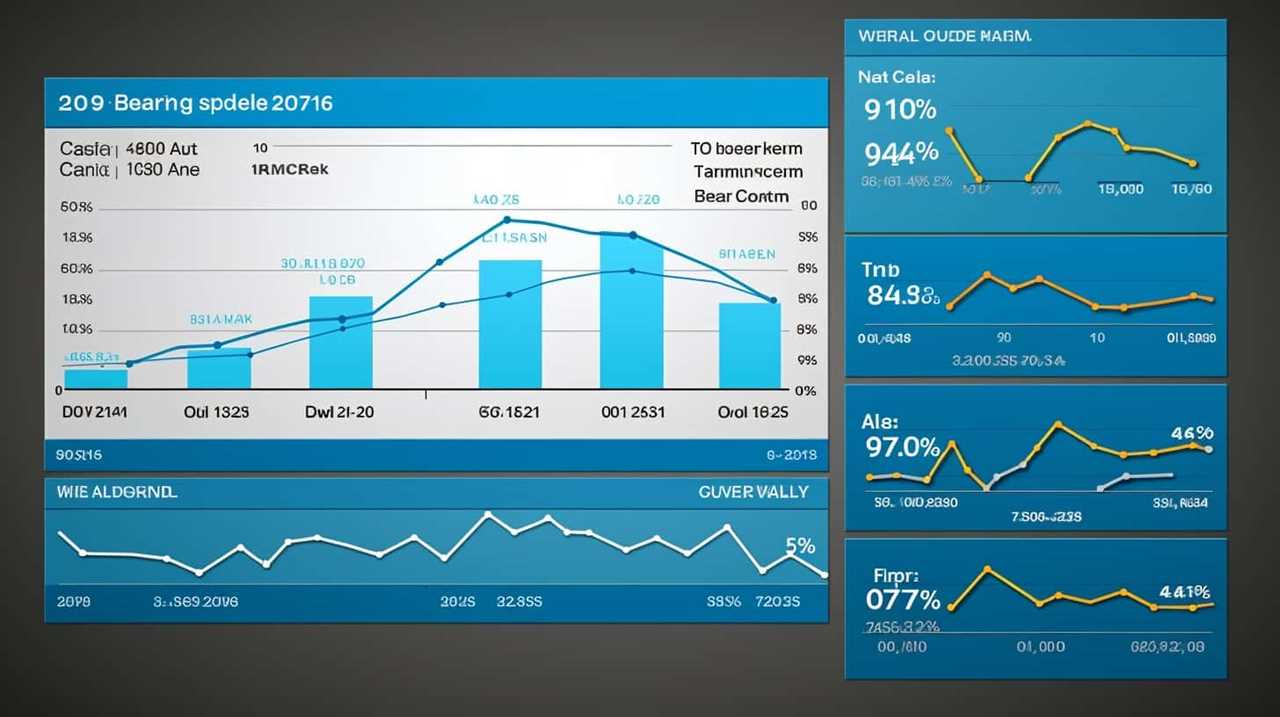In our quest for digital superiority, we must remember the power of our collective. As local non-profit organizations, it’s our responsibility to strengthen our digital presence, enabling us to support more efficiently those who rely on our services.
This article explores the strategic techniques of local SEO, guiding us through the process of identifying target keywords, optimizing website content, and leveraging local influencers.
Let us embark on this journey of data-driven mastery, ensuring our impact is felt far and wide.
Key Takeaways
- Local SEO is crucial for non-profit organizations to increase visibility and attract local supporters.
- Optimizing website content with local keywords and long-tail keywords improves visibility in local search results and drives targeted traffic.
- Accurate and consistent business listings across online directories, including Google Maps, enhance credibility and trustworthiness, making it easier for potential supporters to find the organization.
- Building high-quality backlinks through guest blogging and strategic link building improves search engine rankings and visibility, while online reviews and testimonials help establish a strong online presence and enhance reputation.
Understanding Local SEO
In our journey to optimize for the community, we must first grasp the concept of local SEO. Local SEO is a vital strategy for non-profit organizations looking to increase their visibility and attract more local supporters. By implementing local SEO best practices, non-profits can ensure that their website and online presence are optimized for local search results.

One of the key elements of local SEO is online reputation management. Maintaining a positive online reputation is crucial for non-profits as it directly impacts their credibility and trustworthiness in the community. Non-profits should actively monitor and respond to online reviews and feedback, engage with their audience on social media platforms, and address any negative comments or concerns promptly and professionally.
Furthermore, local SEO best practices involve optimizing website content with local keywords, ensuring accurate and consistent business listings across online directories, and creating location-specific landing pages. Non-profits should also focus on building local citations, which are mentions of their organization’s name, address, and phone number on other websites, to improve their visibility in local search results.
Identifying Target Keywords
When it comes to optimizing our website for local search, identifying target keywords is crucial. We need to focus on relevant local search terms that our target audience is likely to use when looking for the services or information we provide.
Conducting thorough long-tail keyword research will help us uncover specific phrases that have less competition and higher conversion potential, allowing us to strategically optimize our content and drive more targeted traffic to our site.

Relevant Local Search Terms
As we delve into the topic of optimizing SEO strategies for local non-profits, it’s crucial to identify relevant local search terms by conducting thorough keyword research. This step is essential in order to improve local search optimization and increase local search rankings.
Here are three key considerations when identifying target keywords for local non-profits:
- Location-specific keywords: Including city or neighborhood names in your target keywords can help you appear in local search results for users in your area.
- Non-profit mission keywords: Incorporating keywords related to your organization’s mission and cause can attract users who are specifically searching for non-profit services in your community.
- Long-tail keywords: Long-tail keywords are more specific phrases that users may search for, such as ‘volunteer opportunities for children in [your city].’ Including these in your keyword strategy can help you target a more niche audience.
Long-Tail Keyword Research
To continue our exploration of optimizing SEO strategies for local non-profits, let’s delve into the crucial process of conducting long-tail keyword research to identify target keywords for our organization’s online presence.
Keyword competitiveness analysis plays a vital role in this process, as it allows us to assess the difficulty of ranking for specific keywords in our target market. By analyzing factors such as search volume, competition, and relevancy, we can identify keywords that have the potential to drive targeted traffic to our website.

Once we’ve identified these high-potential keywords, it’s time to implement them in our content through long tail keyword implementation. By incorporating these longer, more specific phrases into our website copy, blog posts, and other digital assets, we can increase our chances of ranking higher in search engine results and attracting the right audience to our non-profit organization.
Optimizing Website Content
When it comes to optimizing website content, there are several key points to consider.
First and foremost, incorporating relevant keywords is essential for improving search engine visibility. By strategically including these keywords throughout the content, we can ensure that our website ranks higher in search results.
Additionally, it’s important to create engaging and informative content that not only attracts users but also keeps them on our site for longer periods of time.

Lastly, implementing local targeting strategies can help us connect with our community and drive more traffic to our website.
Relevant Keywords for SEO
One important step in optimizing website content for SEO is identifying and incorporating a select number of relevant keywords that resonate with our local community.
Conducting thorough and relevant keyword research allows us to understand the language and phrases that our target audience uses when searching for information related to our non-profit. This research helps us uncover the specific terms that will drive organic traffic to our website.
Once we’ve identified these keywords, it’s crucial to optimize our meta tags, including the title tag and meta description. By strategically incorporating our relevant keywords into these tags, we can improve our website’s visibility and click-through rates in search engine results pages.

This optimization technique ensures that our website appears more prominently and attractively to our local community, increasing the likelihood of them visiting our site and engaging with our non-profit.
Engaging and Informative Content
As we continue optimizing our website content for SEO, it’s essential to create engaging and informative content that resonates with our local community.
Creating compelling content is crucial for capturing the attention of our audience and keeping them engaged. We can achieve this by understanding the needs and interests of our community and tailoring our content accordingly.
By conducting thorough research and utilizing data-driven insights, we can identify the topics and formats that are most likely to resonate with our audience.

Additionally, implementing effective content promotion strategies will ensure that our content reaches a wider audience and generates more visibility for our organization.
Local Targeting Strategies
To optimize our website content for the local community, we focus on implementing local targeting strategies. These strategies involve leveraging local citation building and local link building techniques. Here’s how we do it:
- Local citation building: We ensure that our business information, such as name, address, and phone number, is consistent across various online directories and platforms. This helps to establish our credibility and improve our local search rankings.
- Local link building: We actively seek out local partnerships and collaborations to acquire high-quality backlinks from reputable local websites. These local links not only drive traffic to our site but also signal to search engines that our website is relevant and trustworthy within the local community.
Utilizing Local Business Directories
In our experience, we’ve found that leveraging local business directories is crucial for optimizing the online presence of local non-profits. Local citation building, which involves listing your non-profit’s name, address, and phone number on various directories, plays a significant role in improving your search engine rankings and increasing your visibility to potential donors and volunteers.
By ensuring that your non-profit is listed accurately and consistently across multiple directories, you’re effectively establishing your presence in the local community. This not only helps potential supporters find you more easily but also enhances your credibility in their eyes. When people see that your non-profit is listed in reputable directories alongside other local businesses, they’re more likely to trust and engage with your organization.

One directory that can’t be overlooked is Google Maps. Optimizing your Google Maps listing is essential for local non-profits, as it allows you to showcase your location, hours of operation, and other relevant information to potential visitors. Additionally, by encouraging positive reviews on your Google Maps listing, you can further improve your online reputation and attract more people to your cause.
Creating and Managing Online Listings
When it comes to creating and managing online listings for local non-profits, accuracy is crucial. Ensuring that your organization’s information is up-to-date and consistent across various platforms is essential for building trust with your community.
Additionally, optimizing your online listings with local SEO strategies can greatly benefit your non-profit by increasing visibility and attracting more potential supporters.
Listing Accuracy Importance
We believe that ensuring the accuracy of our online listings is vital for effectively creating and managing our online presence as a local non-profit organization. Maintaining listing accuracy optimization and proper local citation management is crucial for the following reasons:

- Visibility: Accurate online listings help our organization be easily found by potential supporters and volunteers. It increases our visibility in search engine results and local directories.
- Consistency: Consistent and accurate information across different online platforms builds trust and credibility. It ensures that our audience receives accurate and up-to-date information about our organization.
- Local SEO: Implementing listing accuracy optimization strategies improves our local search engine optimization efforts. It helps us rank higher in local searches, attracting more local supporters and donors.
Local SEO Benefits
To maximize our online presence and effectively engage with our community, optimizing local SEO benefits through creating and managing online listings is essential.
Local SEO strategies allow us to increase our visibility in search engine results when users search for local nonprofit organizations or related keywords. By creating accurate and up-to-date online listings on platforms such as Google My Business, Yelp, and local directories, we can ensure that our organization appears in relevant search results.
These online listings not only provide users with important information such as our address, phone number, and website, but they also serve as a valuable source of reviews and ratings that can build trust and credibility with our audience. By actively managing and monitoring our online listings, we can respond to reviews, provide timely updates, and maintain a consistent brand presence across different platforms.
This not only improves our local SEO rankings but also enhances our reputation and strengthens our connection with the community.

As we focus on optimizing our online presence through local SEO benefits, the next step is building high-quality backlinks to further boost our visibility and authority in search engine rankings.
Building High-Quality Backlinks
Building high-quality backlinks is an essential aspect of optimizing our website for improved search engine rankings and visibility. In order to effectively build these backlinks, we need to employ strategic link building strategies that will attract reputable and authoritative websites to link to our content.
Here are three key strategies to consider:
- Create valuable and shareable content: By producing high-quality and informative content, we increase the likelihood of other websites linking back to us. This can include blog posts, infographics, or even videos that provide value to our target audience.
- Guest blogging: Writing guest posts for relevant and reputable websites in our industry allows us to showcase our expertise and gain valuable backlinks. It’s important to ensure that the websites we collaborate with have a strong online presence and align with our organization’s values.
- Optimize anchor text: The anchor text used for our backlinks plays a crucial role in search engine optimization. It’s important to use descriptive and relevant anchor text that accurately reflects the content being linked to. This helps search engines understand the context of the link, improving our website’s visibility and credibility.
Implementing Schema Markup
To enhance our website’s search engine optimization, we can incorporate schema markup to provide structured data that improves the visibility and understanding of our content. Schema markup for non-profits is a powerful tool that helps search engines better understand the context and relevance of our website. By implementing schema markup, we can provide search engines with additional information about our organization, events, articles, and other content, leading to higher visibility and better search rankings.

When implementing schema markup for non-profits, there are a few key tips to keep in mind. Firstly, it’s important to identify the specific types of schema markup that are relevant to our organization. For example, we can use the ‘Organization’ schema to provide details about our non-profit, such as its name, address, and contact information. Additionally, we can use the ‘Event’ schema to provide information about upcoming events, including dates, times, and locations.
Another tip is to ensure that the schema markup is correctly implemented on our website. This can be done by adding the appropriate schema markup code to the relevant pages. It’s also important to regularly test the markup using tools like Google’s Structured Data Testing Tool to ensure that it’s being recognized and interpreted correctly by search engines.
Improving Website Loading Speed
Improving website loading speed is essential for maximizing user experience and search engine optimization.
To achieve this, we can employ various techniques such as:

- Image compression: By compressing images, we can reduce their file size without compromising quality, resulting in faster loading times.
- Caching and CDN integration: Implementing caching and CDN integration helps to store and deliver website content more efficiently, further improving loading speed.
- Minimizing JavaScript files: Minimizing the use of JavaScript files can also contribute to faster load times, optimizing the overall performance of the website.
Image Compression Techniques
We prioritize image compression techniques to enhance the loading speed of our website. By reducing file size through image optimization techniques, we can significantly improve the user experience and increase overall website performance.
Here are three key benefits of implementing image compression:
- Faster Loading Speed: Compressed images load faster, reducing the waiting time for users and improving their browsing experience.
- Improved SEO: Search engines value fast-loading websites, and by optimizing images, we can improve our website’s ranking in search engine results.
- Reduced Bandwidth Usage: Compressed images require less bandwidth, allowing for faster page loading and reducing data usage for users.
Caching and CDN Integration
Our team has successfully integrated caching and CDN to significantly improve our website’s loading speed.
By implementing effective caching techniques, we’re able to store frequently accessed data and deliver it quickly to our users. This reduces the time required to load content, resulting in a seamless user experience.

Additionally, our CDN implementation ensures that our website’s files are distributed across multiple servers strategically placed around the world. This reduces the distance between our server and the user, minimizing latency and improving loading times.
The combination of caching and CDN integration has allowed us to optimize our website’s performance, resulting in faster page load times and improved user satisfaction.
With these strategies in place, we’re able to provide a smooth and efficient browsing experience for our audience.
Minimizing Javascript Files
How can minimizing Javascript files enhance the loading speed of a website for local non-profits?

Website performance plays a crucial role in user experience and search engine rankings. By reducing server requests, non-profit websites can improve loading speed and provide a seamless browsing experience for their visitors.
Here are three ways minimizing Javascript files can enhance website loading speed:
- Removing unused scripts: Eliminating unnecessary Javascript files reduces the amount of data that needs to be loaded, resulting in faster load times.
- Consolidating scripts: Combining multiple Javascript files into a single file minimizes server requests, reducing the time it takes to fetch and load resources.
- Asynchronous loading: Loading Javascript files asynchronously allows other elements of the website to load simultaneously, improving overall loading speed.
By implementing these strategies, local non-profits can optimize their website’s performance and provide a faster and more efficient user experience.
Now, let’s explore the importance of mobile optimization for local searches.

Mobile Optimization for Local Searches
For local non-profits, optimizing mobile search results is crucial in reaching the community. In today’s digital age, more and more people are using their smartphones to search for local businesses and organizations. Therefore, it’s essential for non-profits to ensure that their websites are mobile-friendly and easily accessible on mobile devices.
To optimize for local search trends, non-profits should focus on implementing mobile-friendly design elements such as responsive layouts and fast loading speeds. This will improve the user experience and increase the chances of attracting and retaining visitors to their websites.
Another important aspect of mobile optimization is optimizing for voice search. With the rise of voice assistants like Siri and Alexa, more people are using voice commands to search for information. Non-profits can benefit from this trend by optimizing their content for voice search queries. This can be done by incorporating long-tail keywords and natural language in their website content.
By optimizing for mobile search and voice search, local non-profits can increase their visibility and reach within the community. This will ultimately lead to higher engagement and more opportunities for community involvement.

In the next section, we’ll explore the importance of utilizing social media for local engagement and how non-profits can leverage these platforms to connect with their target audience.
Utilizing Social Media for Local Engagement
As we delve into the topic of ‘Utilizing Social Media for Local Engagement’, it’s important to recognize the influence that these platforms have on connecting local non-profits with their target audience. Social media engagement plays a crucial role in community outreach for non-profits, allowing them to build relationships, raise awareness, and drive action.
Here are three key ways in which social media can be utilized for local engagement:
- Creating meaningful content: Sharing compelling stories, impactful visuals, and informative posts on social media platforms can capture the attention of your target audience and inspire them to engage with your organization.
- Encouraging dialogue and interaction: Social media provides a platform for two-way communication, allowing non-profits to actively engage with their followers. Responding to comments, answering questions, and fostering discussions can help to build a sense of community and encourage further engagement.
- Leveraging user-generated content: Encouraging your followers to share their own experiences, testimonials, and stories related to your cause can amplify your reach and increase community involvement. Sharing user-generated content not only empowers your supporters but also establishes trust and authenticity.
Encouraging Online Reviews and Testimonials
Continuing the discussion on utilizing social media for local engagement, we recognize the importance of encouraging online reviews and testimonials in building trust and credibility. Generating positive reviews is crucial for local non-profits to establish a strong online presence and attract more supporters. According to a recent study, 88% of consumers trust online reviews as much as personal recommendations. By leveraging user testimonials, organizations can showcase the positive experiences of their past donors, volunteers, and beneficiaries.

To encourage online reviews, it’s essential to make the process as seamless as possible. Start by setting up profiles on popular review platforms such as Google My Business, Yelp, and Facebook. These platforms not only allow users to leave reviews but also provide valuable visibility for your organization.
Additionally, consider implementing a review management strategy. Respond to all reviews, whether positive or negative, in a timely and professional manner. This shows your commitment to listening to feedback and resolving issues. Encourage supporters to leave reviews by including a call-to-action in your email newsletters, social media posts, and website.
User testimonials are another powerful tool for building trust. Incorporate testimonials on your website and social media channels, highlighting the impact of your work. Consider reaching out to your most engaged supporters and ask them to share their experiences in a video or written format.
Leveraging Local Influencers
To effectively leverage local influencers, we can collaborate with them to amplify our organization’s message and expand our reach within the community. Influencer marketing has become a powerful tool in the digital era, allowing us to tap into the networks and followers of influential individuals in our local area. By partnering with these influencers, we can benefit from their established credibility and trust, gaining access to a wider audience that aligns with our mission and values.

When it comes to collaborating with local businesses, there are several strategies we can employ to maximize the impact of our influencer marketing efforts:
- Identify relevant influencers: Conduct thorough research to find influencers who’ve a significant following within our target community. Look for individuals who’ve a genuine interest in our cause and can effectively communicate our message.
- Develop authentic partnerships: Approach influencers with a genuine desire to collaborate, focusing on building long-term relationships rather than one-off promotions. This approach will ensure that the influencers we work with are genuinely invested in our cause and are more likely to promote our organization to their followers.
- Create valuable content: Work closely with influencers to develop content that resonates with their audience while highlighting our organization’s impact and initiatives. This will help generate meaningful engagement and encourage their followers to take action in support of our cause.
Utilizing Google My Business
Now let’s explore how we can make the most of Google My Business to enhance our organization’s online presence and connect with our local community.
Google My Business is a powerful tool that allows us to claim and verify our business listing on Google. By doing so, we can ensure that our organization’s information is accurate and up-to-date, making it easier for potential supporters to find us online.
One of the key features of Google My Business is the ability to utilize Google Maps for local visibility. When we optimize our listing with relevant keywords and categories, we increase our chances of appearing in local search results. This means that when individuals in our community search for non-profit organizations like ours, they’re more likely to find our listing and visit our website or physical location.

Additionally, Google My Business provides valuable insights and data that can help us understand how our organization is performing online. We can track metrics such as the number of views, clicks, and calls our listing receives, allowing us to measure the effectiveness of our online presence. By analyzing this data, we can make data-driven decisions to further optimize our listing and improve our visibility within the local community.
Tracking and Analyzing SEO Performance
As we delve into tracking and analyzing our SEO performance, let’s build upon our previous strategies to gain valuable insights and make data-driven improvements for our local non-profit organization. Implementing effective strategies for tracking and analyzing SEO performance is crucial for ensuring the success of our online presence. Here are three key steps to guide us in this process:
- Set up a robust analytics system: By utilizing tools like Google Analytics, we can track important metrics such as website traffic, keyword rankings, and user engagement. This data will provide us with a comprehensive view of our SEO performance and help us identify areas for improvement.
- Monitor keyword performance: Regularly track how our target keywords are performing in search engine rankings. This will allow us to identify trends, measure the impact of our efforts, and make necessary adjustments to optimize our content.
- Analyze competitor data: Keep a close eye on our competitors’ SEO strategies and performance. By analyzing their keyword rankings, backlink profiles, and content strategies, we can gain valuable insights and identify opportunities to stay ahead in the search results.
Staying Updated With Algorithm Changes
We regularly stay informed about the latest algorithm changes to ensure the effectiveness of our SEO strategies for our local non-profit organization. Staying updated with algorithm changes is crucial in the ever-evolving world of search engine optimization. Search engines constantly update their algorithms to provide users with the most relevant and high-quality search results. As a result, websites that fail to adapt to these changes may see a decline in their search rankings and organic traffic.
To help you understand the importance of staying updated with algorithm changes, here is a table summarizing some of the key algorithm updates that have had a significant impact on SEO strategies in recent years:

| Algorithm Update | Date | Key Changes |
|---|---|---|
| Panda | February 2011 | Targeted low-quality content and penalized sites with thin content |
| Penguin | April 2012 | Focused on link quality and penalized sites with spammy backlinks |
| Hummingbird | August 2013 | Improved understanding of search queries and introduced semantic search |
| RankBrain | October 2015 | Utilized artificial intelligence to interpret search queries and provide more relevant results |
Conclusion
In conclusion, optimizing for the community through local SEO strategies is a crucial step for non-profit organizations.
By understanding local SEO, identifying target keywords, and optimizing website content, non-profits can increase their visibility to their local audience.
Utilizing local business directories and creating online listings can further enhance their online presence and make it easier for potential supporters to find them.
Leveraging local influencers can also help non-profits reach a wider audience and gain more visibility in the community.

Additionally, utilizing Google My Business can improve their local search rankings and provide important information to potential supporters.
Finally, tracking SEO performance is essential to measure the effectiveness of their strategies and make necessary adjustments.
By staying updated with algorithm changes, non-profits can stay ahead in the digital landscape and continue making a meaningful impact in their community.









